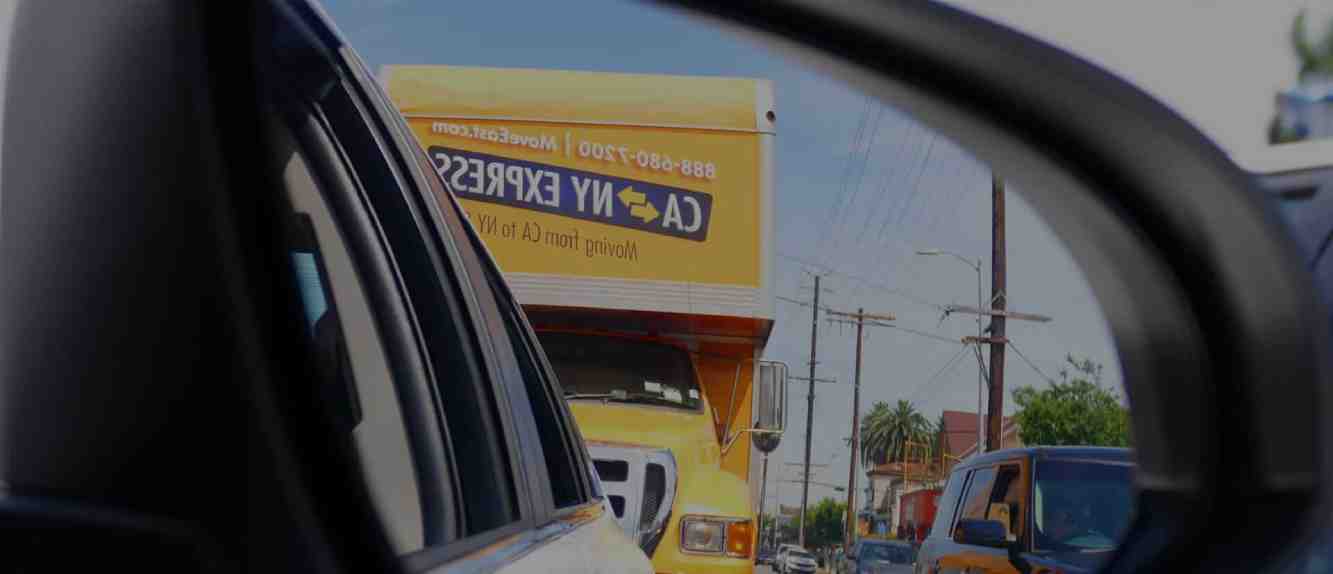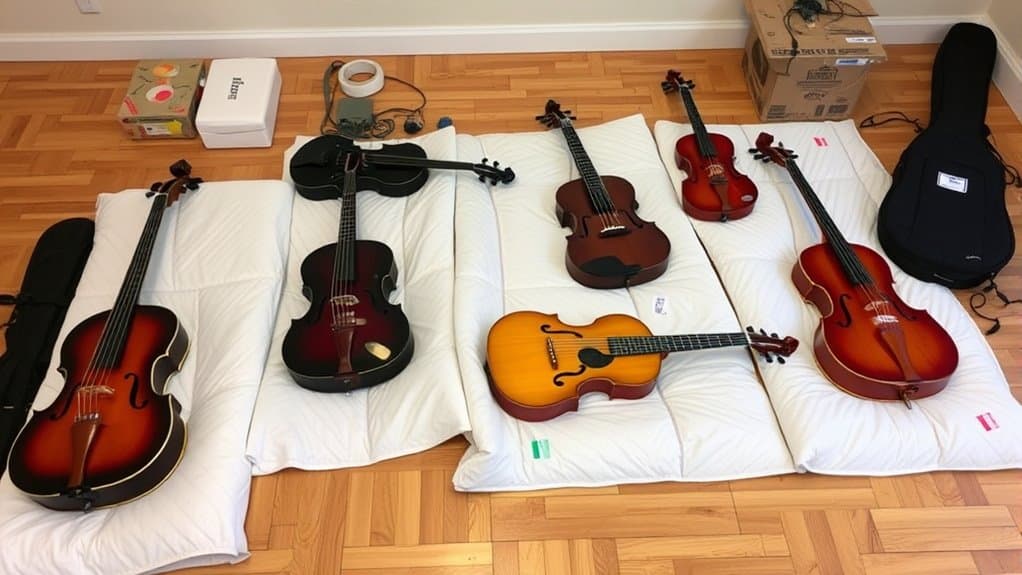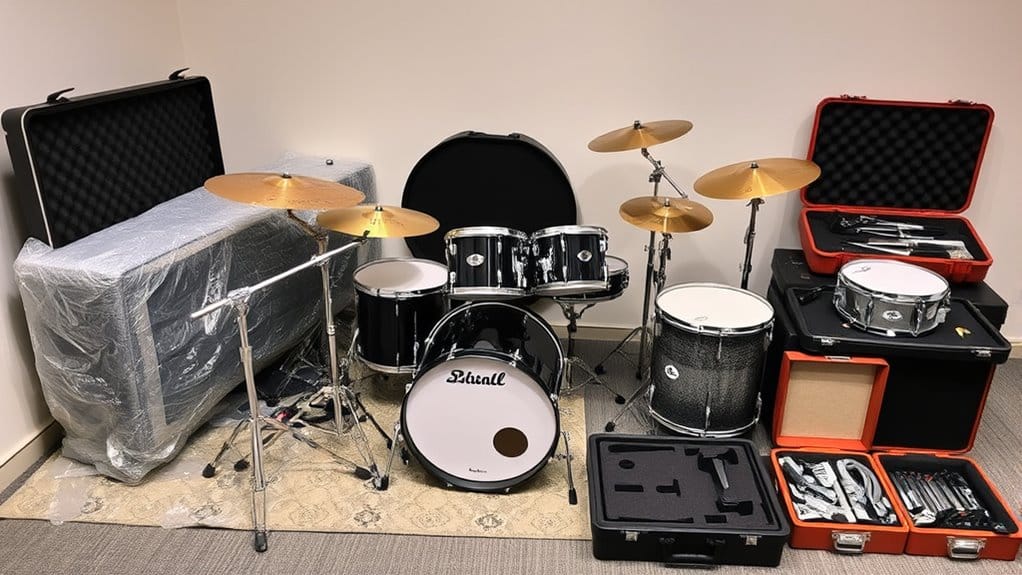To handle perishables and plants safely, you'll need temperature-controlled equipment and proper packaging materials. Use airtight containers and maintain temperatures between 35-40°F for perishables, while wrapping plant root balls in damp newspaper and plastic. Keep raw meats separate from other items, and secure all cargo to prevent movement during transit. Clean all surfaces before and after transport, and monitor temperatures consistently. The success of your transport depends on understanding the specific requirements for each item type.
Essential Equipment and Supplies for Safe Transport
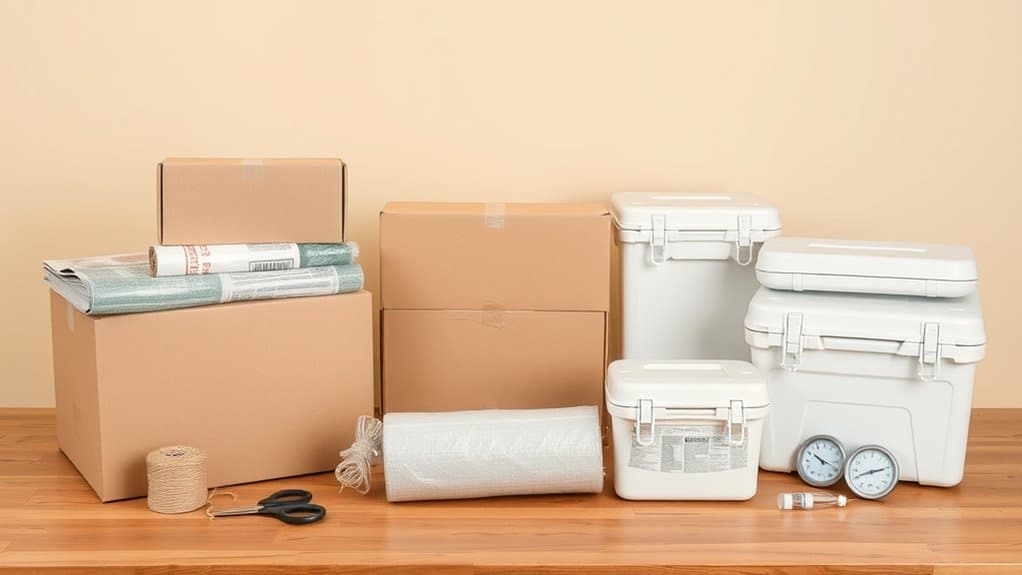
Success in transporting perishables and plants relies heavily on having the right equipment and supplies at your disposal.
The essential equipment you'll need includes stainless steel vehicles with proper insulation, secure anchoring systems, and durable linings to protect your cargo from contamination and damage during transit.
Your packaging materials should feature airtight containers and moisture-resistant wrapping to maintain ideal conditions for your goods.
Don't forget to use shock-absorbing inserts for fragile items and pest-resistant materials to prevent infestations.
You'll also need proper handling equipment like pallets, straps, and anti-skid mats to keep your cargo stable.
For safe loading and unloading, make sure you're equipped with forklifts and dollies.
Remember to maintain cleanliness with sanitizable containers and appropriate cleaning supplies.
Temperature Control During Transit
When transporting perishables and plants, you'll need to master cold chain basics that maintain specific temperature ranges throughout the journey.
You can protect your cargo by using appropriate temperature-controlled equipment, such as reefer trucks for fresh produce (0-8°C) or dry ice solutions for frozen items (below -20°C).
Time-temperature monitoring is essential, so you'll want to implement IoT sensors and automated logging systems to track any deviations and guarantee your shipment stays within safe temperature zones from pickup to delivery.
Cold Chain Basics
Maintaining precise temperature control throughout transit stands as the cornerstone of effective cold chain management.
You'll need to understand the essential components that guarantee your perishables arrive safely at their destination. Cold chain importance can't be overstated, as proper temperature monitoring prevents product loss and maintains quality.
- Use wireless sensors and IoT devices to track real-time temperature data during transport
- Implement both active cooling systems (refrigeration units, dry ice) and passive methods (thermal blankets, gel packs)
- Install cloud-based monitoring platforms to detect and respond to temperature fluctuations quickly
- Follow strict documentation protocols to maintain compliance with regulatory requirements
- Conduct regular validation testing of packaging integrity and temperature control systems
Remember to combine these elements strategically, as each plays an essential role in maintaining your cold chain's integrity.
Time-Temperature Safety Tips
Three critical components form the foundation of effective temperature control during transit: robust monitoring systems, proper cooling methods, and reliable packaging solutions.
To prevent temperature spikes during transport, you'll need to place monitoring devices at strategic points within your containers. These data loggers provide real-time tracking and alert you to any fluctuations that could compromise your shipment.
Make sure you're using mechanical refrigeration as your primary cooling method, supplemented with phase-change cold packs when needed. Your packaging should include insulated containers with moisture-resistant seals and reflective liners.
Remember to train your team on temperature data interpretation and establish clear threshold limits. Keep backup cooling supplies ready, and always verify temperatures at transfer points to maintain the cold chain's integrity throughout the journey.
Proper Packing Methods for Plants
When you're shipping plants, you'll need to start with properly securing the root ball by wrapping it in damp newspaper and securing it with plastic wrap to maintain essential moisture.
Your choice of container matters greatly, so select sturdy corrugated boxes with proper partitioning to prevent movement and protect multiple plants during transit.
You'll also want to guarantee your shipment uses climate-controlled transport methods, keeping temperatures stable while maintaining appropriate humidity levels throughout the journey.
Secure Root Ball Wrapping
Secure root ball wrapping serves as the foundation for successful plant transportation and transplantation. When you're preparing root balls, it's crucial to use proper wrapping materials and techniques to guarantee plant survival.
You'll need to carefully select biodegradable burlap and reinforced twine while maintaining controlled tension throughout the process.
Here are the key steps for effective root ball wrapping:
- Apply the drum lace method with star-shaped patterns for large root balls
- Secure twine to trunk loops rather than directly on stems
- Use moisture-managed burlap to prevent root desiccation
- Implement proper tension control to avoid restricting root growth
- Test root ball firmness before finalizing the wrap
Remember to remove any non-biodegradable materials before planting and trim excess burlap above the soil line to prevent water retention issues.
Plant Container Selection
Beyond wrapping root balls, successful plant transportation depends heavily on selecting the right containers and implementing proper packing methods.
You'll need to choose containers based on your plants' specific requirements, considering both container aesthetics and essential drainage solutions. Select durable materials like plastic, ceramic, or wood that'll maintain structural integrity during transport.
For root vegetables, opt for deep cylindrical containers, while climbing plants need tall, vertical options.
Don't forget to incorporate proper drainage holes to prevent waterlogging. When packing, fill containers halfway with moist soil mixed with time-release fertilizer, then add your plants and secure them with additional soil.
Leave about 8 inches of space for root expansion, and arrange plants using the thriller-filler-spiller method for ideal stability and visual appeal during transport.
Climate-Controlled Transport Methods
The successful transport of plants requires carefully controlled climate conditions throughout their journey. To maximize transport efficiency, you'll need to maintain temperatures between 65-75°F while managing humidity levels effectively. Climate control systems guarantee your plants arrive healthy and stress-free.
Key elements for successful plant transport include:
- Use climate-controlled vehicles with temperature monitoring systems
- Pack roots in damp materials and maintain proper spacing between plants
- Secure containers with anti-vibration mats to prevent tipping
- Water plants 1-2 days before transport, avoiding in-transit watering
- Implement real-time monitoring for temperature and humidity control
For longer journeys, opt for specialized truckload services rather than LTL shipping to maintain consistent conditions. This approach minimizes handling and helps preserve plant quality throughout the transportation process. Additionally, understanding state and federal regulations regarding plant transport can prevent potential fines and ensure compliance during your move.
Storage Guidelines for Perishable Foods
Proper storage of perishable foods plays a critical role in maintaining food safety and quality. Your refrigerator organization should prioritize keeping raw meats separate from other items, and you'll need to maintain temperatures between 35-40°F for ideal preservation.
When it comes to freezer management, guarantee a constant temperature of 0°F and use freezer-safe containers to prevent freezer burn.
You'll want to check storage labels carefully and refrigerate perishables immediately after purchase. Store raw meat, poultry, and dairy products separately to avoid cross-contamination, and don't forget to seal open items in airtight containers.
If you're dealing with leftovers, refrigerate them within two hours of preparation. For shelf-stable items that you've opened, like peanut butter, they'll need refrigeration to maintain freshness.
Vehicle Preparation and Loading Strategies
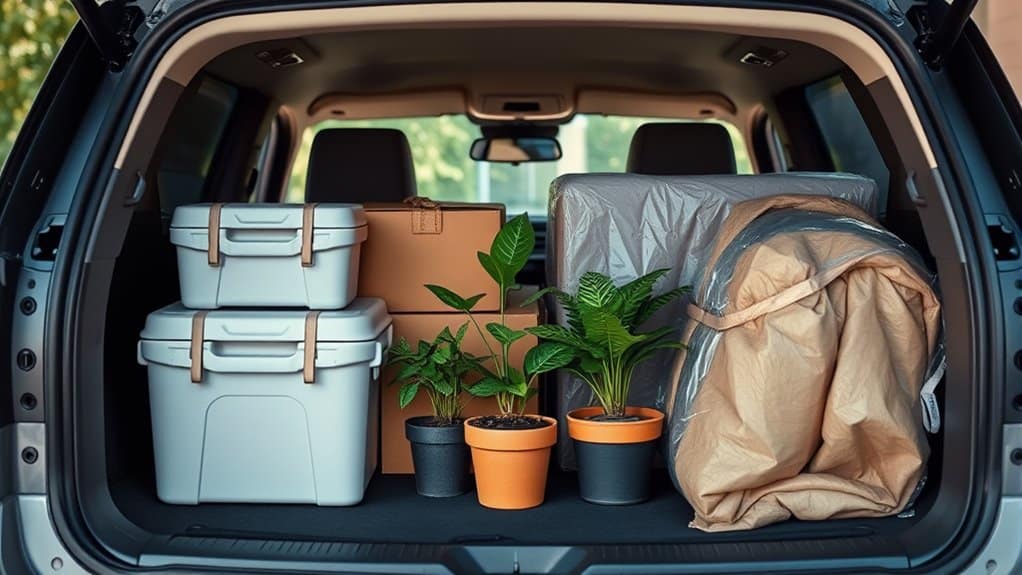
Successful transport of perishables and plants requires thorough vehicle preparation and strategic loading procedures. Before loading any items, you'll need to complete extensive vehicle inspections and implement proper pest management protocols to guarantee food safety compliance.
- Sanitize all surfaces, including refrigeration units and floors, between shipments.
- Check seals, insulation, and cooling systems for proper functionality.
- Apply pest control measures and seal potential entry points.
- Use tamper-evident packaging and segregate different food types.
- Monitor temperature controls and install tracking devices.
When loading your vehicle, start with temperature-sensitive items first and stack heavier items near the floor.
You'll want to maintain separate zones for raw and ready-to-eat products to prevent cross-contamination.
Remember to document load positions and use rigid packaging materials to protect against movement during transit.
Time Management and Route Planning
Once your vehicle is properly prepared and loaded, mastering time management and route planning becomes your next major focus.
You'll need to analyze traffic patterns, weather conditions, and potential road closures to optimize your route efficiency. Using real-time tracking systems, you can quickly adjust your course when delays occur.
Your delivery scheduling should prioritize routes with minimal stops to protect temperature-sensitive items.
When planning your timeline, build in buffer periods for unexpected disruptions and allocate shorter delivery windows for high-risk perishables.
You'll want to coordinate closely with recipients to confirm dock availability and reduce waiting times.
For cross-border shipments, prepare your customs documentation in advance and familiarize yourself with regional regulations.
Remember to monitor loading and unloading durations carefully to maintain proper temperature conditions throughout the journey.
Unpacking and Post-Move Care
After completing your delivery route, careful attention to unpacking and post-move care will protect your perishables and plants from damage.
A thorough post-move inspection guarantees your items remain safe for consumption and your plants adapt to their new environment. Start with these essential steps:
- Clean all storage containers and surfaces before restocking perishables
- Transfer refrigerated items immediately to maintain proper temperature
- Check expiration dates and discard any compromised items
- Acclimate plants gradually to new lighting conditions
- Monitor plant health for signs of stress or damage
Focus on food safety by storing items at appropriate temperatures and preventing cross-contamination.
Sort your pantry items by category, keeping frequently used items accessible.
For plants, maintain consistent watering schedules and avoid sudden environmental changes that could shock their systems.
Conclusion
Just like nurturing a delicate flower, handling perishables and plants requires careful attention to detail. You've now got the fundamental knowledge to maintain freshness and liveliness during transport. By following these temperature control, packing, and storage guidelines, you'll guarantee your items arrive in prime condition. Remember, success lies in thorough preparation and proper timing. Put these strategies into practice, and you'll master the art of transporting sensitive cargo safely and efficiently.
